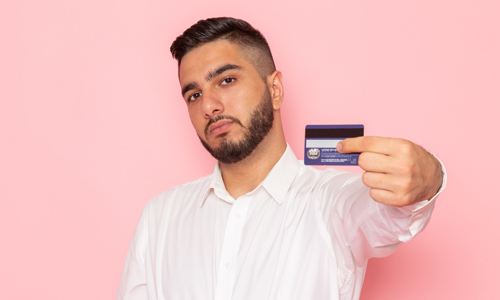Overdraft or Credit Cards: Which is Better to Borrow money?

Sometimes certain circumstances in life leave you no option but to borrow some money. It could be due to lack of resources or lack of cash liquidity at the time, or simply because you need a large sum of money quickly.
A lot of people believe that borrowing money is not a financially healthy habit. But this is not always the case. Borrowing, if done for the right reasons and properly, can help you set up your business, fund your child’s education, enable you to buy the house of your dreams, and improve the overall quality of your life. But if misused, it can also trap you in a vicious spiral of debt. Thus, while some debt is necessary others can prove to be a devastating blow to your financial health. Caution and discipline are, therefore, the key to managing debt.
Among the many different types of credit facilities available, most borrowers prefer to get a credit card or an overdraft loan. Both of these credit alternatives come with an added rate of interest on the principal amount borrowed or used. Which one is the most suitable for you? It essentially depends on your personal requirements.
It might seem confusing to some as to how an overdraft loan can match the numerous benefits offered by a credit card. Personal overdraft however is extremely useful as a line of credit option for the majority of salaried workers since its benefits come very close to the ones provided by a credit card loan. Let us understand better by comparing the options closely an understanding which is indeed better to borrow money:
Overdraft and credit card loans are both personal credit lines which simply means that they give you advance money that has to be repaid most likely with interest. Different factors prompt one’s decision of choosing between overdraft or credit cards.
Several factors that one needs to consider when choosing between a credit card or an overdraft loan:
- Are you eligible for availing of both these options?
- Is the money offered under either alternative enough to cover the sum required by you?
- Which amongst the two has a lower rate of interest?
- Does any of the two options charge annual fees?
- While using the overdraft line of credit do you have to pay an overdraft fee?
Ask yourself these questions and then calculate which option is going to cost you less.
Credit Cards Loan:
Credit cards need no introduction due to their massive presence in today’s world. They have become an easy substitute for carrying cash around. Being great instruments for managing one’s finances, credit cards allow us to pay for things conveniently while also offering some excellent rewards. They have made our day to day transactions efficient and gratifying.
The interest-free or grace period offered initially with credit cards as a welcome bonus allows cardholders to get credit up to their pre-approved limit. Once this period is over, an interest rate is charged monthly on the outstanding amount. Credit card loans are thus, a part of our monthly bill repayments and this rate of interest charged is much more crucial than the annual fees or other accompanying charges that hold the attention of the majority of cardholders who want to either get a credit card or are already using one. This interest, if not appropriately managed, will essentially contribute to making the ownership of the credit card an expensive affair.
How does a credit card loan work?
Credit cards also work as a line of credit. It is a revolving credit line, meaning that it is flexible or open-ended in contrast to a finite loan that has to be paid back within a fixed period of time. This credit card loan can be as big as the credit limit approved by your issuers. This means that it can be as big as the amount you can charge on your credit card.
Using credit cards for buying goods and services means that you are borrowing money from your credit card company. At the end of the month, you have to repay that borrowed amount that was given in advance. If, however, you borrow money by using the card that you cannot possibly repay fully, then this becomes your outstanding balance of the month. This balance will also incur an interest amount that depends on the type of credit card as well as your credit Score.
If a credit card user is unable to pay the total amount utilized by them once the cycle is over, they have two options. They can either pay the entire amount that is due alongside the interest or they can pay a minimum amount that is predominantly the interest part of the bill. If they get in a habit of paying the minimum amount each month while utilizing their card, the total outstanding balance and the interest added to that becomes exponentially high.
It is henceforth imperative to maintain a stable Credit Utilization Ratio that usually lies at sound 30 percent or below the total available credit limit. This helps you gain confidence as a responsible borrower in the eyes of the creditors but it also helps in keeping the financial liabilities in check.
Overdraft Loan
This is a loan facility or a line of credit that enables its borrowers to make withdrawals in parts. This loan is drawn out from the pre-approved credit limit and one has to pay a sum incurred due to the interest charged monthly. For instance, if the approved credit limit is AED 100,00 and the borrower wishes to only use AED 30,000 out of it, they will withdraw this amount and pay a monthly interest amount on this withdrawn amount.
One might be compelled to ask why this is helpful? The secret lies in the rate of interest. An overdraft loan for salaried professionals comes at almost half the rate of interest as opposed to the interest rate that is charged on credit cards. Additionally, taking out an overdraft loan helps in being able to build a better sense of financial discipline in contrast to credit cards. This is because the amount of interest is paid in monthly instalments while the withdrawn amount can be repaid anytime without having to worry about any additional charges.
How does an overdraft work?
Those who have an overdraft protection plan at their banks, their spending can be beyond the actual amount that is in their attached checking account. Doing this would not cause the check to bounce as it normally does. On the contrary, their bank will have to honour it by advancing the amount. For this service, they will have to pay the interest to the bank on the amount overdrawn from the account.
Some lines of credit that provide overdraft loans will charge an additional fee for every single overdraft while others have an annual fee instead or alongside the overdraft fees. Since this overdraft is essentially a personal line of credit, the bank will only let you borrow the sum on the basis of your credit worthiness apart from the bank’s policies.
Other than this, the interest rate charged on an overdraft facility is only applicable for the number of days that the amount is utilized as well as only on the cash that is withdrawn.
Given underneath is a quick comparison of the two to highlight their individual advantages and disadvantages better:
| Loan Type | Advantages | Disadvantages | Most Suitable For |
|---|---|---|---|
| CREDIT CARD LOAN |
|
|
|
| OVERDRAFT LOAN |
|
|
|
For instance, your car needs repairs worth AED 1,200 but you only have AED 200 in your account at the moment. You write a check of AED 1,200 to the garage. The overdraft loan offered by your bank will enable you to borrow the amount of AED 1,200 at an interest rate of let’s say 18 percent annually. Additionally, you will also have to pay an overdraft fee of AED 12.50. In order to pay back this loan within one year, you will have to pay AED 216 as interest along with AED 12.50 as the overdraft fees.
A credit card on the other hand lets you borrow the sum at an introductory charge of 12% interest annually for a period of one year. If the card comes with no annual fee, you will only have to pay an interest of AED 144.
In this scenario the credit card proves to be a better choice. But if the credit card comes with a higher APR (Annual Percentage Rate) or with an annual, or both, the obvious choice would have been an overdraft loan.

Things to Remember if you are Choosing a Credit Card over Overdraft
Pick a credit card that is in alignment with how you wish to borrow money-
- If you want to borrow to pay off another credit card, go for 0 % balance transfer cards
- If you want to borrow to spread the cost of any large purchase made by you, go for a 0 % purchase credit card
- If you want to borrow cash, go for a 0 % money transfer card
Things to Remember if you are Choosing an Overdraft loan over Credit Cards
- The line of credit is given on the basis of pre-sanctioned loans against assets offered as collateral like FDs, bonds etc
- Interest rate charged will depend on the asset offered as collateral
- Overdraft limit will also depend on the asset offered as collateral
- Any negative balance needs to be repaid within a month
The Bottom Line
Both the facilities have their fair share of pros and cons. Credit card loans are generally better if you have planned expenses but overdrafts can be useful in cases of emergency. You can avoid the embarrassment of a bounced check due to insufficient funds by utilizing overdrafts. Regardless of that, both lines of credit bear penalty APRs, meaning the interest will increase enormously if you miss payments. So, be careful too make your payments on time irrespective of which one you choose.
More From Credit Cards
- Recent Articles
- Popular Articles
















